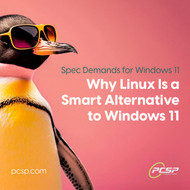Why Linux Is a Smart Alternative to Windows 11
May 22nd 2025
Why Linux Is a Smart Alternative to Windows 11
As Windows 11 tightens its hardware demands—TPM 2.0, Secure Boot, and modern CPU limits—many users are eyeing more flexible, cost-effective options. That’s where Linux shines. It’s open-source, highly customizable, and runs effortlessly on a wide range of machines, including refurbished workstations. Whether you're a newcomer or a seasoned pro, these six Linux distributions—Ubuntu, Debian, Fedora, Linux Mint, Pop!_OS, and Manjaro—offer robust alternatives that skip the headaches of Windows 11, while delivering smooth, stable performance.
Ubuntu: Clean, Easy, and Capable
Ubuntu stands out for its user-friendliness and modern design. With its GNOME desktop, the layout feels familiar—making it an excellent choice for Windows converts. It boasts an extensive app library and great community support. Plus, it works on older hardware without needing TPM or a fancy CPU. If you want a no-fuss Linux experience, Ubuntu’s a solid bet.
- Snap packages simplify installing and updating apps.
- A software center that feels like an app store.
- LTS versions offer five years of steady updates.
- Strong out-of-the-box hardware compatibility.
Debian: Built to Last
Debian is famous for its rock-solid stability. It’s a favorite among those who prefer reliability over frequent changes. The system is lightweight and customizable—great for developers, sysadmins, and everyday users alike. It’s efficient on aging hardware and supports a massive package repository. For anyone after a long-term, low-maintenance OS, Debian delivers.
- Robust APT package management.
- 60,000+ packages to choose from.
- Long support cycles (up to five years).
- Multiple desktop environments available.
Fedora: Fast, Fresh, and Forward-Looking
Fedora keeps you on the cutting edge. Backed by Red Hat, it’s well-suited for devs and tech-savvy users who want the latest tools. Fedora stays sleek with its polished GNOME interface, and it doesn’t demand premium hardware. It’s ideal for those who love innovation without being locked into Microsoft’s ecosystem.
- DNF package manager for snappy updates.
- Ships with the latest GNOME desktop.
- Modular updates for testing new tech.
- Strong focus on open-source standards.
Linux Mint: A Smooth Shift from Windows
Linux Mint makes switching from Windows feel effortless. Its Cinnamon desktop mimics the classic Windows layout, which lowers the learning curve. Fast, efficient, and preloaded with essential apps, Mint is perfect for home users or small offices wanting to dodge hardware constraints. It's simple, practical, and familiar.
- Windows-style Cinnamon desktop.
- Comes with LibreOffice, VLC, and more.
- Easy-to-use software manager.
- Built-in system backup with Timeshift.
Pop!_OS: Designed for Creators and Gamers
Pop!_OS, from System76, is tailor-made for creators and gamers. With automatic window tiling and built-in NVIDIA support, it’s great for video work, 3D modeling, or serious gaming. It’s clean, powerful, and skips Windows 11’s hardware hurdles. Creative pros will appreciate the workflow-focused design.
- Auto-tiling window layouts.
- Pop!_Shop app center.
- Native NVIDIA drivers for seamless GPU use.
- Enhanced GNOME for better productivity.
Manjaro: Arch Simplicity for Everyone
Manjaro brings the power of Arch Linux to the masses—without the complexity. It’s beginner-friendly, yet powerful enough for developers and gamers. The rolling-release model means you always have up-to-date software. Manjaro handles older hardware well and doesn’t rely on TPM or Secure Boot, making it a flexible go-to for modern users.
- Rolling updates keep software fresh.
- Pamac GUI for painless app installs.
- Choose from KDE, GNOME, or XFCE.
- Built-in hardware detection and driver setup.
Best Refurbished Linux Workstations
These refurbished Dell, HP, and Lenovo machines are Linux-ready and budget-friendly—hand-picked to give you strong performance with zero bloat. Whether you're just getting started or need a workstation for heavy lifting, there's something here for every use case.
Budget-Friendly Picks
- Dell Precision T5810: 1x Xeon E5-1600/2600 v3, up to 256GB DDR4, 4x 3.5” or 8x 2.5” bays, 2 GPUs, 685W PSU – great for Ubuntu or Mint.
- HP Z440: 1x Xeon E5-1600/2600 v3, up to 128GB DDR4, 2x 3.5” or 4x 2.5” bays, 2 GPUs, 700W PSU – ideal for Fedora or Pop!_OS.
- Lenovo P510: 1x Xeon E5-1600/2600 v4, up to 256GB DDR4, 2x 3.5” or 4x 2.5” bays, 2 GPUs, 650W PSU – fits Debian or Manjaro.
Recommended Mid-Range Systems
- Dell Precision T7810: 2x Xeon E5-2600 v3/v4, up to 512GB DDR4, 4x 3.5” or 8x 2.5” bays, 4 GPUs, 825W PSU – handles Fedora or Pop!_OS with ease.
- HP Z640: 2x Xeon E5-2600 v3/v4, up to 256GB DDR4, 2x 3.5” or 4x 2.5” bays, 3 GPUs, 925W PSU – great for Ubuntu or Debian.
- Lenovo P710: 2x Xeon E5-2600 v3/v4, up to 384GB DDR4, 2x 3.5” or 6x 2.5” bays, 3 GPUs, 850W PSU – works great with Mint or Manjaro.
High-End Powerhouses
- Dell Precision T7910: 2x Xeon E5-2600 v3/v4, up to 1TB DDR4, 4x 3.5” or 8x 2.5” bays, 4 GPUs, 1300W PSU – ideal for AI or high-end rendering on Fedora or Ubuntu.
- HP Z840: 2x Xeon E5-2600 v3/v4, up to 2TB DDR4, 4x 3.5” or 10x 2.5” bays, 4 GPUs, 1125W PSU – perfect for data science or simulation on Debian or Pop!_OS.
- Lenovo P920: 2x Xeon E5-2630 v3/v4, up to 1TB DDR4, 2x 3.5” or 8x 2.5” bays, 4 GPUs, 1000W PSU – great for CAD, VR, or scientific research on Manjaro or Ubuntu.
Final Word: Linux + Refurb = Smart Upgrade
There’s never been a better time to ditch Windows 11. Pairing Linux with a powerful refurbished workstation is a cost-effective, high-performance path forward. Whether you go budget with a T5810 or all-out with an HP Z840, you’ll get a clean, open, and efficient setup. Explore our selection today and find a system that fits your workflow—and your wallet.

